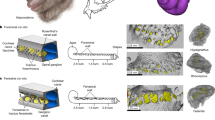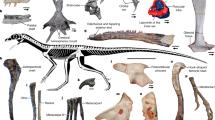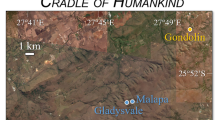Abstract
The earliest-known bats are represented by excellent fossil material, including virtually complete skeletons of Icaronycteris index from the early Eocene (50 Myr BP) of western Wyoming1,2 and Palaeochiropteryx tupaiodon from the middle Eocene (45 Myr BP) ‘Grube Messel’ of western Germany3,4. These taxa have been closely allied1,5 with Recent Microchiroptera, a suborder of diverse bats noted for their powers of ultrasonic echolocation6. A problem with this relationship is the alleged absence in the Eocene forms of specializations in the auditory region7 and other aspects of the skeletal system1,2. It has been proposed, therefore, that the oldest bats are members of a group more primitive and possibly ancestral to the Microchiroptera and the visually oriented Megachiroptera8. Previously undescribed specimens now show, however, that Icaronycteris (Fig. 1) and Palaeochiropteryx (Fig. 2) share special basicranial features with microchiropterans which suggest comparable refinement of ultrasonic echolocation. These results support the theory that a sophisticated sonar system was present in the earliest records of microchiropteran history.
This is a preview of subscription content, access via your institution
Access options
Subscribe to this journal
Receive 51 print issues and online access
$199.00 per year
only $3.90 per issue
Buy this article
- Purchase on Springer Link
- Instant access to full article PDF
Prices may be subject to local taxes which are calculated during checkout
Similar content being viewed by others
References
Jepsen, G. L. Science 154, 1333–1339 (1966).
Jepsen, G. L. in Biology of Bats Vol. 1 (ed. Wimsatt, W. A.) 1–64 (Academic, New York, 1970).
Revilliod, P. Abh. hess. geol. Landesanst. 7, 157–201 (1917).
Richter, G. & Storch, G. Natur. Mus., Frankf. 110, 353–367 (1980).
Smith, J. D. & Storch, G. Senckenberg. biol. 61, 153–167 (1981).
Koopman, K. F. in Orders and Families of Recent Mammals of the World (eds Anderson, S. & Jones, J. K.) 145–186 (Wiley, New York, 1984).
Segal, W. Fieldiana, Zool. 58, 103–108 (1971).
Van Valen, L. Evol. Theory 4, 103–121 (1979).
Stanek, V. J. Nakladen Ceske Akad Ved a Umeni, 1–67 (V. Praze, 1933).
Henson, O. W. Kans. Univ. Sci. Bull. 42, 151–255 (1961).
Tepaske, E. R. thesis, Oklahoma State Univ. (1964).
Fleischer, G. Säugetierk. Mitt. 21, 131–239 (1973).
Fleischer, G. Evolutionary Principles of the Mammalian Middle Ear (Springer, Berlin, 1978).
Henson, O. W. in Biology of Bats Vol. 2 (ed. Wimsatt, W. A.), 181–261 (Academic, New York, 1970).
Novacek, M. J. Proc. 5th int. Bat Res. Conf., 317–330 (Texas Technical Press, Lubbock, 1980).
Sprague, J. M. Am. J. Anat. 72, 385–472 (1943).
Griffiths, T. A. Mammalia 47, 377–394 (1983).
Pye, A. J. Morph. 119, 101–120 (1966).
Bruns, V. Verh. dt. zool. Ges. 141–154 (1979).
Bruns, V., Fiedler, J. & Kraus, H. J. Myotis Vols 21–22 (1983–1984).
van der Klaauw, C. J. Bull. Am. Mus. nat. Hist. 62, 1–352 (1931).
Suthers, R. A. & Fattu, J. M. Am. Zool: 13, 1215–1226 (1973).
von Bekesy, G. Experiments in Hearing (McGraw-Hill, New York, 1960).
Dallos, P. The Auditory Periphery (Academic, New York, 1960).
Harris, D. M. & Dallos, P. Science 225, 741–743 (1984).
Novacek, M. J. Proc. 1st int. Congr. Vert. Morphol. (Fischer, Stuttgart, in the press.)
Simmons, J. A., Howell, D. J. & Suga, N. Am. Sci. 63, 204–215 (1975).
Fenton, M. B. Q. Rev. Biol. 59, 33–53 (1984).
Author information
Authors and Affiliations
Rights and permissions
About this article
Cite this article
Novacek, M. Evidence for echolocation in the oldest known bats. Nature 315, 140–141 (1985). https://doi.org/10.1038/315140a0
Received:
Accepted:
Issue Date:
DOI: https://doi.org/10.1038/315140a0
This article is cited by
-
The vocal apparatus: An understudied tool to reconstruct the evolutionary history of echolocation in bats?
Journal of Mammalian Evolution (2023)
-
Hetero-integration enables fast switching time-of-flight sensors for light detection and ranging
Scientific Reports (2020)
-
Extreme sensitivity to ultraviolet light in the fungal pathogen causing white-nose syndrome of bats
Nature Communications (2018)
-
Comparative inner ear transcriptome analysis between the Rickett’s big-footed bats (Myotis ricketti) and the greater short-nosed fruit bats (Cynopterus sphinx)
BMC Genomics (2013)
-
Inferring echolocation in ancient bats
Nature (2010)
Comments
By submitting a comment you agree to abide by our Terms and Community Guidelines. If you find something abusive or that does not comply with our terms or guidelines please flag it as inappropriate.



